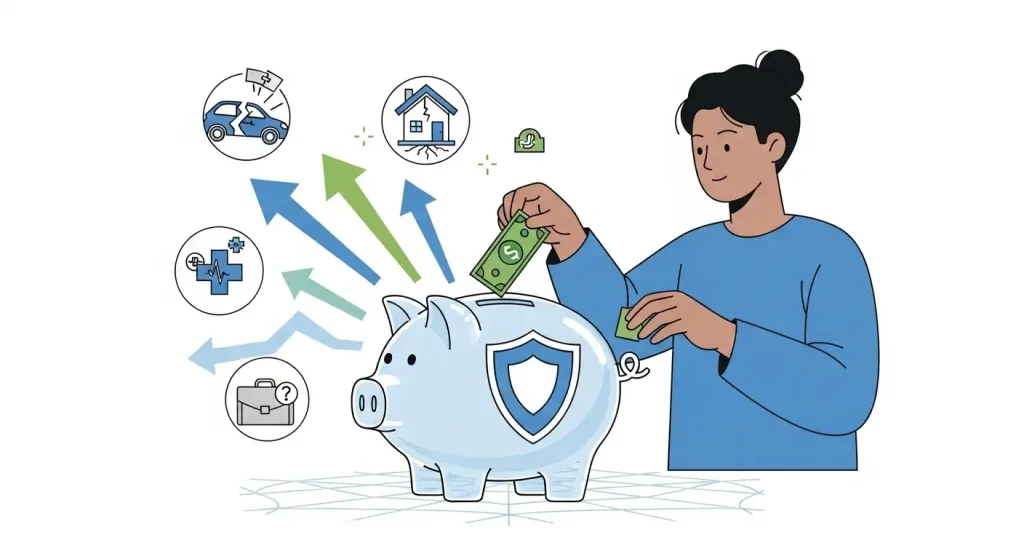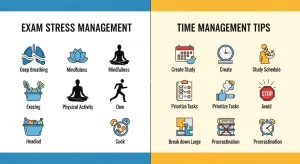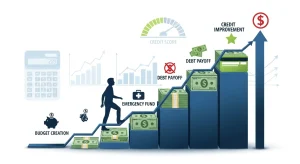Building an emergency fund is one of the most important steps you can take toward achieving financial security and peace of mind. In today’s uncertain economic climate, having a solid financial safety net can mean the difference between weathering a financial storm and falling into debt when unexpected expenses arise.
Whether you’re starting from zero or looking to strengthen your existing emergency savings, this comprehensive guide will show you exactly how to create and maintain an emergency fund that protects your financial future. With 79% of Americans planning to grow their emergency funds in 2025, there’s never been a better time to prioritize this crucial aspect of personal finance.
Top Fitness Trackers & Smartwatches 2025: Ultimate Guide
What Is an Emergency Fund and Why Do You Need One?
An emergency fund is a dedicated savings account containing money specifically set aside for unexpected expenses or financial emergencies. Unlike regular savings goals, your emergency savings should only be used for true emergencies, such as:
- Job loss or income reduction
- Medical emergencies and unexpected healthcare costs
- Major car repairs or transportation issues
- Home repairs from damage or appliance failures
- Family emergencies requiring travel or financial support
The Financial Benefits of Emergency Fund Planning
Emergency fund planning provides numerous advantages that extend far beyond avoiding debt:
- Stress Reduction: Knowing you’re prepared for unexpected expenses reduces financial anxiety
- Debt Prevention: Having cash available prevents reliance on high-interest credit cards
- Financial Flexibility: An emergency fund allows you to take calculated risks like career changes
- Investment Protection: You won’t need to withdraw from long-term investments during emergencies
- Better Decision Making: Financial pressure won’t force you into poor financial choices
How Much Should You Save in Your Emergency Fund?
The question of how much to save in your emergency fund depends on your individual circumstances, but financial experts generally recommend specific guidelines:
Standard Emergency Fund Recommendations
| Situation | Recommended Amount |
|---|---|
| Single income, stable job | 3-6 months of expenses |
| Dual income household | 3-4 months of expenses |
| Self-employed/irregular income | 6-12 months of expenses |
| Starting out with debt | $1,000 minimum starter fund |
Financial experts recommend three to six months’ worth of your current living expenses as a good rule of thumb for emergency fund targets, which acts as a financial buffer to help avoid going into debt from unexpected events.
Calculating Your Target Emergency Fund Amount
To determine your specific emergency fund goal, follow these steps:
- Calculate monthly essential expenses:
- Housing (rent/mortgage, utilities, insurance)
- Food and groceries
- Transportation costs
- Minimum debt payments
- Healthcare and insurance premiums
- Multiply by your target months (3-6 months typically)
- Consider your risk factors:
- Job security and industry stability
- Health conditions or age factors
- Number of dependents
- Home ownership responsibilities
Plant-Based Clean Eating Guide: Transform Your Health
Step-by-Step Guide to Building Your Emergency Fund
Step 1: Start Small and Build Momentum
Building an emergency fund doesn’t require dramatic lifestyle changes. Building an emergency fund might seem daunting, but it doesn’t have to happen all at once. Start small and focus on consistency rather than perfection.
Initial savings targets:
- Week 1: Save $25-50
- Month 1: Reach $200-500
- Month 3: Achieve $1,000 starter fund
- Month 12: Build to full 3-6 month target
Step 2: Automate Your Emergency Savings
Automatic transfers remove the temptation to spend money before saving it:
- Set up direct deposit to automatically transfer a percentage to your emergency fund
- Schedule weekly or bi-weekly transfers instead of monthly for faster progress
- Start with a small amount you won’t miss, then gradually increase
- Use “pay yourself first” mentality by treating savings like a non-negotiable bill
Step 3: Find Extra Money for Your Emergency Fund
Emergency fund strategies for accelerating your savings include:
Cut Unnecessary Expenses
- Cancel unused subscriptions and memberships
- Reduce dining out and cook more meals at home
- Lower utility bills through energy-saving measures
- Negotiate bills like insurance, phone, and internet services
Increase Your Income
- Sell unused items around your home
- Take on freelance work or side gigs
- Claim tax refunds and bonuses directly to emergency savings
- Use cashback and rewards programs strategically
Complete Guide to Holistic Self-Care Practices
Where to Keep Your Emergency Fund
The best location for your emergency savings balances accessibility with earning potential:
High-Yield Savings Accounts
Advantages:
- FDIC insured up to $250,000
- Easy access to funds
- Competitive interest rates (4-5% APY in 2025)
- No investment risk
Best for: Most people building their first emergency fund
Money Market Accounts
Advantages:
- Higher interest rates than traditional savings
- Check-writing privileges for emergencies
- FDIC insurance protection
- Tiered interest rates for larger balances
Best for: Those with larger emergency funds ($10,000+)
Certificates of Deposit (CD) Ladders
Advantages:
- Guaranteed returns
- Higher interest rates for longer terms
- FDIC insurance protection
- Forced savings discipline
Best for: Advanced savers with fully-funded emergency funds
HIIT vs Functional Training: Which Burns Fat Faster?
Common Emergency Fund Mistakes to Avoid
Understanding emergency fund pitfalls helps maintain progress and fund integrity:
1. Using Emergency Funds for Non-Emergencies
True emergencies are unexpected, necessary, and urgent. Vacations, holiday gifts, and planned purchases don’t qualify.
2. Not Replenishing After Use
After using your emergency savings, immediately prioritize rebuilding it to full strength.
3. Keeping Too Much in Low-Interest Accounts
While accessibility is important, earning competitive interest helps your fund grow and maintain purchasing power.
4. Not Adjusting for Life Changes
Update your emergency fund goal when your expenses increase due to:
- Job changes or promotions
- Marriage or new dependents
- Home purchases or relocations
- Health condition changes
Advanced Emergency Fund Strategies
Creating Multiple Emergency Funds
Consider segmented emergency savings for different purposes:
- Immediate access fund: $1,000-2,000 in checking or high-yield savings
- Short-term emergencies: 1-2 months expenses in high-yield savings
- Extended emergencies: 4-6 months expenses in money market or CDs
- Home emergency fund: Separate fund for homeowners covering major repairs
Building Emergency Funds on Different Incomes
Low-Income Emergency Fund Building
- Start with $500-1,000 as initial target
- Use micro-saving apps that round up purchases
- Save loose change and small bills daily
- Focus on free activities to reduce expenses
- Utilize community resources when available
High-Income Emergency Fund Building
- Aim for 6-12 months of expenses
- Consider tax-advantaged accounts like HSAs for medical emergencies
- Diversify across multiple banks for FDIC insurance coverage
- Include investment accounts for extended unemployment protection
Recovery Gear: Massage Guns vs Foam Rollers for Peak Performance
Technology Tools for Emergency Fund Success
Emergency Fund Apps and Tools
Popular apps for building your financial safety net:
- Digit: Analyzes spending and saves small amounts automatically
- Qapital: Rounds up purchases and invests spare change
- YNAB (You Need A Budget): Comprehensive budgeting with emergency fund tracking
- Mint: Free budget tracking with savings goal features
- Acorns: Micro-investing with emergency fund options
Emergency Fund Calculators
Use online emergency fund calculators to determine your target amount and track progress toward your savings goals.
How to Read Food Labels Like a Nutritionist
Frequently Asked Questions
How Long Does It Take to Build an Emergency Fund?
Building an emergency fund typically takes 6-24 months depending on your income and savings rate. If you can save $200 monthly, reaching a $2,400 emergency fund (3 months of $800 expenses) would take 12 months. The key is starting immediately and maintaining consistency.
Should I Invest My Emergency Fund?
Emergency savings should remain easily accessible and stable, so traditional investing isn’t recommended for your primary emergency fund. However, once you have 3-6 months saved in cash, you might consider investing additional funds for extended unemployment protection while keeping your core emergency fund liquid.
What If I Can’t Afford to Save for Emergencies?
Even on tight budgets, emergency fund building is possible through small, consistent actions. Start by saving $1-5 daily, selling unused items, or using cashback apps. Focus on building a $500 starter fund first, then gradually increase. Remember that research shows $2,000 in an emergency fund can be just as powerful as having $1M in assets when it comes to financial well-being.
The Benefits of Drinking Warm Lemon Water Every Morning
Taking Action: Your Emergency Fund Next Steps
Now that you understand the importance and strategies of building an emergency fund, it’s time to take action:
- Calculate your target amount using the guidelines above
- Open a high-yield savings account dedicated to emergencies only
- Set up automatic transfers starting this week
- Find one expense to cut to accelerate your savings
- Track your progress monthly and celebrate milestones
Ready to start building your financial safety net?
to open a high-yield emergency fund savings account and begin protecting your financial future today.
Conclusion
Building an emergency fund is the foundation of financial security and provides invaluable peace of mind in an uncertain world. By following the strategies outlined in this guide, you can create a robust financial safety net that protects you from unexpected expenses and financial emergencies.
Remember that emergency fund planning is a marathon, not a sprint. Start small, stay consistent, and gradually build your fund over time. Every dollar you save brings you closer to financial security and the confidence that comes with being prepared for life’s unexpected challenges.
The most important step is getting started today. Even if you can only save $25 this week, you’re beginning the crucial habit of emergency savings that will serve you throughout your financial journey.











